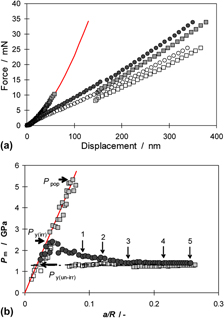Crossref Citations
This article has been cited by the following publications. This list is generated based on data provided by
Crossref.
Grieveson, E.M.
Armstrong, D.E.J.
Xu, S.
and
Roberts, S.G.
2012.
Compression of self-ion implanted iron micropillars.
Journal of Nuclear Materials,
Vol. 430,
Issue. 1-3,
p.
119.
Hardie, Christopher D.
Roberts, Steve G.
and
Bushby, Andrew J.
2012.
Mechanical Behavior of Ion-Irradiated Fe-Cr alloys Investigated by Spherical Indentation.
MRS Proceedings,
Vol. 1424,
Issue. ,
Armstrong, David E.J.
and
Britton, T.B.
2014.
Effect of dislocation density on improved radiation hardening resistance of nano-structured tungsten–rhenium.
Materials Science and Engineering: A,
Vol. 611,
Issue. ,
p.
388.
Xia, Y.Z.
Bei, H.
Gao, Y.F.
Catoor, D.
and
George, E.P.
2014.
Synthesis, characterization, and nanoindentation response of single crystal Fe–Cr–Ni alloys with FCC and BCC structures.
Materials Science and Engineering: A,
Vol. 611,
Issue. ,
p.
177.
Armstrong, D.E.J.
Hardie, C.D.
Gibson, J.S.K.L.
Bushby, A.J.
Edmondson, P.D.
and
Roberts, S.G.
2015.
Small-scale characterisation of irradiated nuclear materials: Part II nanoindentation and micro-cantilever testing of ion irradiated nuclear materials.
Journal of Nuclear Materials,
Vol. 462,
Issue. ,
p.
374.
Hardie, Christopher D.
Roberts, Steve G.
and
Bushby, Andy J.
2015.
Understanding the effects of ion irradiation using nanoindentation techniques.
Journal of Nuclear Materials,
Vol. 462,
Issue. ,
p.
391.
Pathak, Siddhartha
Kalidindi, Surya R.
Weaver, Jordan S.
Wang, Yongqiang
Doerner, Russell P.
and
Mara, Nathan A.
2017.
Probing nanoscale damage gradients in ion-irradiated metals using spherical nanoindentation.
Scientific Reports,
Vol. 7,
Issue. 1,
Jin, K.
Xia, Y.
Crespillo, M.
Xue, H.
Zhang, Y.
Gao, Y.F.
and
Bei, H.
2018.
Quantifying early stage irradiation damage from nanoindentation pop-in tests.
Scripta Materialia,
Vol. 157,
Issue. ,
p.
49.
Weaver, Jordan S.
Sun, Cheng
Wang, Yongqiang
Kalidindi, Surya R.
Doerner, Russ P.
Mara, Nathan A.
and
Pathak, Siddhartha
2018.
Quantifying the mechanical effects of He, W and He + W ion irradiation on tungsten with spherical nanoindentation.
Journal of Materials Science,
Vol. 53,
Issue. 7,
p.
5296.
Chen, W.Q.
Wang, X.Y.
Xiao, X.Z.
Qu, S.L.
Jia, Y.Z.
Cui, W.
Cao, X.Z.
Xu, B.
and
Liu, W.
2018.
Characterization of dose dependent mechanical properties in helium implanted tungsten.
Journal of Nuclear Materials,
Vol. 509,
Issue. ,
p.
260.
Hosemann, Peter
2018.
Small-scale mechanical testing on nuclear materials: bridging the experimental length-scale gap.
Scripta Materialia,
Vol. 143,
Issue. ,
p.
161.
Xiao, Xiazi
Terentyev, Dmitry
and
Yu, Long
2019.
Model for the spherical indentation stress-strain relationships of ion-irradiated materials.
Journal of the Mechanics and Physics of Solids,
Vol. 132,
Issue. ,
p.
103694.
Liu, Hailong
Li, Qiulin
Xu, Ben
Liu, Wei
and
Shu, Guogang
2019.
The effect of dislocations on MnNi-rich clusters in self-ion irradiated FeMnNi alloy.
Journal of Nuclear Materials,
Vol. 519,
Issue. ,
p.
64.
Das, Suchandrima
Yu, Hongbing
Tarleton, Edmund
and
Hofmann, Felix
2019.
Orientation-dependent indentation response of helium-implanted tungsten.
Applied Physics Letters,
Vol. 114,
Issue. 22,
Xiao, Xiazi
Xiao, Cewen
and
Xia, Xiaodong
2020.
Force-depth relationships with irradiation effect during spherical nano-indentation: A theoretical analysis.
Journal of Nuclear Materials,
Vol. 531,
Issue. ,
p.
152012.
Xiao, Xiazi
and
Yu, Long
2020.
Nano-indentation of ion-irradiated nuclear structural materials: A review.
Nuclear Materials and Energy,
Vol. 22,
Issue. ,
p.
100721.
Xiao, Xiazi
Li, Shilin
and
Yu, Long
2021.
Effect of irradiation damage and indenter radius on pop-in and indentation stress-strain relations: Crystal plasticity finite element simulation.
International Journal of Mechanical Sciences,
Vol. 199,
Issue. ,
p.
106430.
Jin, Peng
Shen, Tie-Long
Li, Jing
Yang, Yu-Shan
Chai, Jian-Long
Zhu, Ya-Bin
Cui, Ming-Huan
Liu, Chao
Zhang, Tong-Min
Kang, Long
Li, Jun
Li, Jin-Yu
Jin, Shuo-Xue
Cao, Xing-Zhong
and
Wang, Zhi-Guang
2022.
Spherical nanoindentation stress–strain responses of SIMP steel to synergistic effects of irradiation by H and He ions.
Nuclear Science and Techniques,
Vol. 33,
Issue. 6,
Bakaev, Alexander
Zhao, Junlei
Terentyev, Dmitry
Bonny, Giovanni
Castin, Nicolas
Kuronen, Antti
Kvashin, Nikolai
Nordlund, Kai
Bakaev, Viktor A.
and
Golikov, Igor G.
2022.
Effect of radiation defects on the early stages of nanoindentation tests in bcc Fe and Fe-Cr alloys.
Computational Materials Science,
Vol. 204,
Issue. ,
p.
111151.
Song, Peng
and
Spätig, Philippe
2022.
Effects of ball size and microstructures on indentation curves of Fe9Cr model alloys and tempered martensitic steel Eurofer97.
Nuclear Materials and Energy,
Vol. 30,
Issue. ,
p.
101143.
